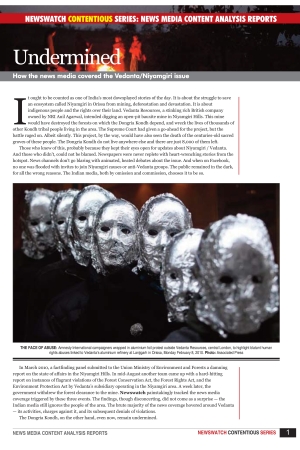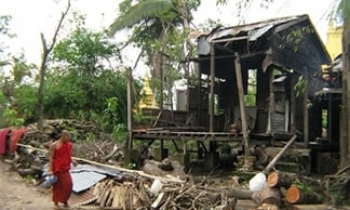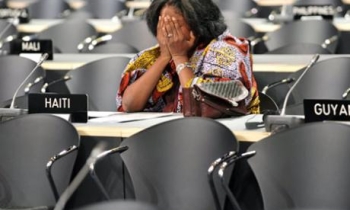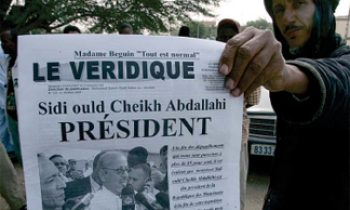The Indian media by and large ignored the indigenous tribals living in the Niyamgiri Hills of Orissa while according lopsided, voluminous coverage to Vedanta during recent developments over the corporate giant’s controversial mining and refinery projects in the eastern state, an independent study has found.
Indian newspapers made passing or no mention of the Dongria Kondh tribals whose very existence would have been at stake had the ministry of environment and forests not rejected the forest clearance for the project. On the other hand, the coverage centered around the UK-based Vedanta Resources and its activities, charges against it, and its denials, found the study by Newswatch, an online monitor that looks at news and developments pertaining to press freedom, journalistic ethics, and the news media industry.
[ Download the full 24-page report in PDF format. ]
[ Browse through the full 24-page report as an e-doc. ]
“The Vedanta/Niyamgiri issue is arguably the most blacked-out story of our times. It is a travesty that among those who had been raising their strident voices against the project, like Survival International and Amnesty International, are not based in India. The ones who are fighting for the Dongria Kondh are primarily local activists and a few concerned civil society members in this country. It is a no-brainer to realise why the media coverage all these days had been a blank, and why it is so Vedanta-centric now,” said Subir Ghosh, founder editor of Newswatch.
The Newswatch study was launched to primarily look at how the news media covered the allegations against Vedanta Resources ending with the rejection of forest clearance of the project by the Union Ministry of Environment and Forests.
The news content analysis was done over three phases.
The release of a report by Amnesty indicting Vedanta over the violations of the rights of the Dongria Kondh formed the backdrop. During March, Union Minister of State for Environment and Forests Jairam Ramesh made a statement saying that the mining giant had violated environmental regulations giving a go-by to tribal rights, on basis of a report submitted by a three-member panel. This was the trigger factor for the first phase of the study. In all, 140 stories published during March were tracked down. Only stories from newspapers, news agencies, major portals, and TV channels were considered for research. Blogs, among others, were not.
In the second phase, only select top English newspapers were chosen for content analysis. Seventeen newspapers were studied. The “breaking news” factor for this phase was the submission on August 17 of the four-member NC Saxena Committee report which looked into the proposal of the Orissa Mining Company for bauxite mining in Niyamgiri.
The same 17 newspapers were studied in the third phase. The trigger for “breaking news” was the announcement on August 24 by Minister Ramesh that the ministry had rejected the forest clearance for the project, and therefore the environmental clearance stood inoperable.
First phase:
- Roughly 85% of the stories after release of the first report were seen to have flat, label headlines. There was a diametrical shift when the government announced that the forest clearance to the mining project had been rejected – about 85% of the stories carried headlines that were seen to be declarative, i.e. making a statement of their own.
- Only one of the 13 stories selected in the first phase, quoted an anti-Vedanta activist. Vedanta scored more with three. No tribal was quoted. The 30 news items that were seen to be follow-ups during the first phase focused more on Vedanta.
- Of the four subsequent features, one was a field story about the charges against Vedanta, one a report on Vedanta’s CSR activities in the region, one a field story that was Vedanta’s version of the events and state of affairs in the Niyamgiri hills, and the last a field feature that carried comments from both Vedanta and tribals of Niyamgiri.
- Of the follow-up stories, eight were analyses of the possible fallout. All these were “colourful” stories pegged at what it meant for Vedanta from the financial point of view. There was only one field report that carried the opinions and grievances of the Niyamgiri people.
- There were four stories that published the Orissa government’s denial of environmental violations. Two were denials from Vedanta. One website carried a story about Vedanta’s CSR activities.
Second phase:
- Three things happened on August 16, 2010. The first was the revelation of the findings of the four-member committee which looked into the proposal of the Orissa Mining Company for bauxite mining in the Niyamgiri hills. The second was Vedanta Resources agreeing to buy as much as 60 per cent of oil and gas explorer Cairn India for $9.6 billion. The third was about the Centre planning to check illegal mining.
- The main Cairn takeover news item was the front page lead in all the five business newspapers studied. In the other newspapers, it was packaged with the front lead in one, displayed as a brief on the front page leading inside in one, and highlighted as the business page lead in six.
- The Saxena report story was the front page lead in only two newspapers. Two of the business newspapers packaged it with their front page lead story on the Cairn acquisition. The mining story was the front lead in one.
- There were more stories about the government’s plans on illegal mining than about the panel report on Vedanta.
- Most newspapers used descriptors that could construed as being sympathetic to Vedanta, and that it was the UK-based company that was being wronged, and not the tribals living in the area. Some even used misleading headlines.
- Vedanta officials were quoted for their reactions, but tribals were not. There was not a single related story from the field in case of the report submission, though newspapers were replete with stories from every angle in case of the Cairn India takeover.
Third phase:
- There was only one story in the 17 newspapers that had a story datelined Lanjigarh.
- The impact that the mining project would have had on the very existence of the Dongria Kondh tribals were ignored by most. Vedanta officials were quoted in quite a few stories, but Niyamgiri tribals were not. Two environmental activists were quoted.
- Seven newspapers featured Union Minister of State for Environment and Forests Jairam Ramesh in the headlines. These headlines gave the impression that it was Ramesh vs Vedanta issue. Another headline, substituted the ministry for the minister. The others too either pitted the Centre against Vedanta, or just said it had upset Vedanta’s plans.
- There were four editorials directly related. Two praised the decision and the need to respect environmental norms, while two outrightly lambasted the minister. The Dongria Kondh tribals were ignored in this case as well.











